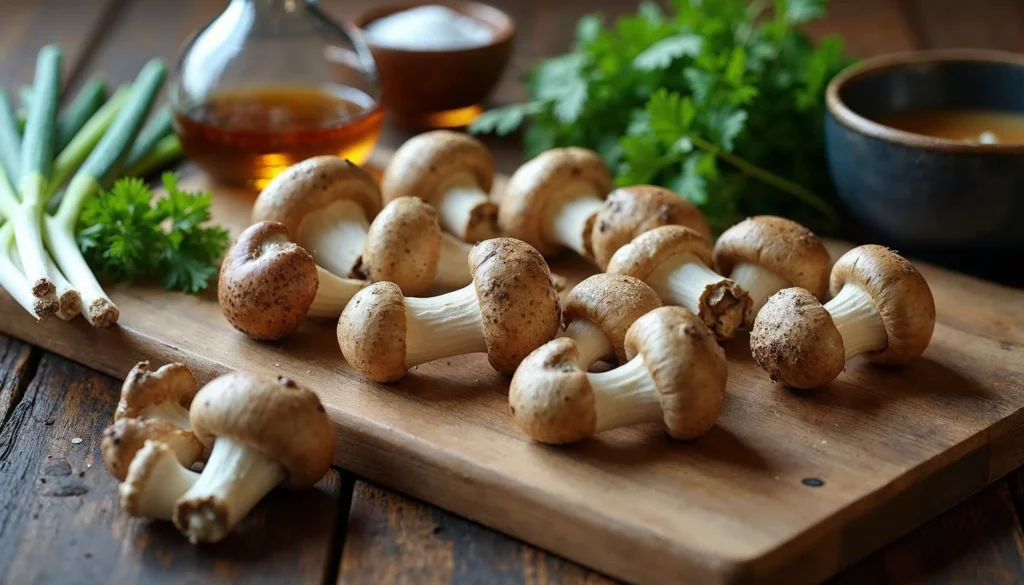The first time I stumbled upon matsutake mushrooms was during a crisp autumn hike in the mountains. I had joined a foraging group, eager to discover the wonders of nature and discover its hidden treasures. Among the pine needles and fallen leaves, a fellow forager excitedly pointed out a peculiar, earthy mushroom with an unmistakably spicy aroma—the matsutake. Intrigued, I took some home and experimented in the kitchen, blending its bold flavor into a simple rice dish. That day, I fell in love with the unique and rare matsutake mushroom recipe that turned an ordinary dinner into a culinary adventure.

Matsutake mushrooms, known for their rich aroma and earthy taste, are a delicacy worth celebrating. Whether you’re an adventurous home cook or a seasoned chef, incorporating these prized mushrooms into your recipes adds depth and sophistication. For a complementary dish, check out this Brazilian Roasted Half Chicken recipe that pairs beautifully with the earthy flavors of matsutake mushrooms. Not only are they a treat for the taste buds, but they also hold cultural significance in Japanese cuisine, symbolizing autumn and good fortune. So, let’s dive into this flavorful journey and unveil the magic of matsutake mushrooms in your kitchen.
Table of contents
Why You’ll Love This Matsutake Mushroom Recipe
This matsutake mushroom recipe is a celebration of simplicity, flavor, and elegance that’s sure to win your heart. First and foremost, it highlights the distinct aroma of matsutake mushrooms, which is spicy, woodsy, and utterly unforgettable. Additionally, the recipe is incredibly versatile, making it perfect for both everyday meals and special occasions. Because matsutake mushrooms are prized for their rarity and depth of flavor, this dish feels luxurious yet approachable. Furthermore, the recipe is simple to follow, requiring minimal ingredients to let the mushrooms truly shine.
Not only is this recipe delicious, but it also provides numerous benefits. Matsutake mushrooms are rich in antioxidants, promoting overall health while delighting your taste buds. Moreover, their unique texture, which is both firm and tender, adds a delightful bite to every mouthful. Whether you’re cooking for yourself or impressing dinner guests, this dish is bound to make a lasting impression. In addition to its gourmet appeal, this recipe is quick to prepare, allowing you to enjoy more time at the table.
Ingredients for Matsutake Mushroom Recipe
To create a flavorful and authentic matsutake mushroom recipe, gather these fresh and simple ingredients. Each item plays a crucial role in enhancing the mushrooms’ unique aroma and taste.

Main Ingredients
- Matsutake mushrooms – 200 grams, cleaned and sliced thinly for even cooking.
- Short-grain rice – 1 cup, rinsed thoroughly to remove excess starch.
- Dashi broth – 2 cups, prepared fresh or from high-quality powder for a rich umami base.
- Soy sauce – 2 tablespoons, light soy sauce works best for balanced seasoning.
- Mirin – 1 tablespoon, to add a hint of sweetness and depth to the dish.
- Sake – 1 tablespoon, optional but recommended for enhancing the mushrooms’ natural aroma.
- Salt – 1/2 teaspoon, adjust to taste depending on your broth’s saltiness.
Optional Garnishes
- Green onions – 2 tablespoons, finely chopped for a fresh and vibrant topping.
- Sesame seeds – 1 teaspoon, toasted for an added nutty flavor.
- Nori strips – A small sheet, cut into thin strips for a touch of texture and umami.
By assembling these ingredients, you’ll be ready to create a matsutake mushroom recipe that’s both simple and extraordinary.
How to Make Matsutake Mushroom Recipe
Follow these simple steps to create a delicious matsutake mushroom recipe that highlights the mushrooms’ unique aroma and flavor.
1: Prepare the Matsutake Mushrooms
- Gently clean matsutake mushrooms using a damp cloth to remove dirt; avoid rinsing to preserve their flavor.
- Slice the mushrooms thinly for even cooking and better absorption of seasonings.
2: Rinse and Soak the Rice
- Rinse short-grain rice in cold water until the water runs clear to remove excess starch.
- Soak the rice in water for 30 minutes to guarantee even cooking and a tender texture.
3: Make the Flavor Base
- Combine dashi broth, soy sauce, mirin, and sake in a pot or rice cooker bowl.
- Stir well to create a flavorful liquid base for the dish.
4: Layer the Ingredients
- Drain the soaked rice and add it to the pot or rice cooker bowl.
- Layer the sliced matsutake mushrooms evenly on top of the rice for uniform cooking.
5: Cook the Rice and Mushrooms
- Cook the rice and mushrooms in a rice cooker or stovetop pot until the rice is tender and aromatic.
- Let the cooked rice rest for 10 minutes with the lid on to bring out the flavors.
6: Garnish and Serve
- Fluff the rice gently with a rice paddle to mix the mushrooms evenly.
- Garnish with green onions, toasted sesame seeds, and nori strips for added flavor and texture.
Enjoy this matsutake mushroom recipe warm, savoring every bite of its earthy and umami-rich goodness!
How to Store Matsutake Mushroom Recipe
Proper storage is essential to preserve the freshness and flavor of your matsutake mushroom recipe. By following these simple tips, you can enjoy your leftovers without compromising taste or texture.
Storing Leftovers in the Refrigerator
To store in the refrigerator, transfer the cooled matsutake mushroom recipe into an airtight container. Make sure the container is sealed tightly to prevent moisture loss and contamination. Store the container in the coldest part of your fridge, typically near the back. Leftovers will remain fresh for up to 3 days if stored properly. When reheating, use a stovetop on low heat, adding a splash of water or dashi to restore moisture. Alternatively, microwave in short intervals, stirring gently to heat evenly.
Can You Freeze Matsutake Mushroom Recipe?
Yes, you can freeze this matsutake mushroom recipe for extended storage. To freeze, first allow the dish to cool completely. Then, portion it into freezer-safe bags or containers, removing excess air to prevent freezer burn. Label each container with the date for easy tracking. When you’re ready to enjoy it, thaw the dish overnight in the refrigerator. Reheat on the stovetop or in the microwave, adding a bit of broth to improve the texture.
By storing your matsutake mushroom recipe correctly, you can savor its rich flavors anytime without sacrificing quality.
Serving Suggestions for Matsutake Mushroom Recipe
Take your matsutake mushroom recipe with these creative and practical serving ideas, perfect for any occasion or preference.
Pairing Options for a Complete Matsutake Mushroom Recipe
For a balanced meal, pair this matsutake mushroom recipe with light and refreshing sides. A crisp cucumber salad dressed with sesame oil and rice vinegar complements the dish beautifully. Additionally, miso soup adds warmth and depth, enhancing the umami flavors of the mushrooms. If you prefer something heartier, serve with grilled fish or teriyaki chicken to create a satisfying main course.
Presentation Tips for an Elegant Touch
When serving, use a shallow bowl or plate to highlight the vibrant colors of the garnishes. Sprinkle green onions and sesame seeds generously for a pop of color and texture. Adding a side of pickled vegetables or a small dollop of wasabi improves the presentation and flavor. For an extra-special touch, serve the dish in individual portions using small Japanese rice bowls.
Variations for Different Occasions
This matsutake mushroom recipe is versatile and can be adapted for various tastes. For a vegan version, use vegetable broth instead of dashi and skip the sake. To add protein, mix in cooked shrimp or diced tofu. For festive gatherings, consider layering the dish with thinly sliced chestnuts or truffle shavings.
With these ideas, your matsutake mushroom recipe will shine as a memorable centerpiece or delightful side!
Mistakes to Avoid When Making Matsutake Mushroom Recipe
Even the most experienced cooks can make missteps when preparing a matsutake mushroom recipe. Avoid these common mistakes to make certain your dish turns out perfectly every time.
Overwashing the Matsutake Mushrooms
One major mistake is rinsing the mushrooms under running water. Matsutake mushrooms absorb water easily, which dilutes their unique flavor. Instead, gently clean them with a damp cloth or brush to remove dirt while preserving their aroma.
Using Too Many Seasonings
Because matsutake mushrooms have a bold, earthy taste, overpowering them with excessive seasonings or spices is a common error. Stick to light soy sauce, dashi, and mirin to accentuate, not mask, the natural flavor of the mushrooms.
Not Rinsing the Rice Thoroughly
Failing to rinse the rice properly can result in a sticky, clumpy texture that detracts from the dish’s overall quality. Wash the rice several times until the water runs clear to achieve a fluffy texture.
Overcooking the Dish
Leaving the rice and mushrooms on heat for too long can cause dryness or mushiness. To avoid this, follow the cooking times closely and allow the dish to rest after cooking to absorb flavors evenly.
By sidestepping these pitfalls, your matsutake mushroom recipe will be a flawless, flavorful masterpiece every time!
FAQs
How to Best Cook Matsutake?
The best way to cook matsutake mushrooms is by keeping the preparation simple to highlight their natural, earthy flavor. Traditional methods like steaming, grilling, or adding them to rice dishes work wonderfully. Thinly slicing the mushrooms guarantees even cooking and helps release their aromatic profile. Pairing them with light seasonings such as soy sauce, mirin, and dashi brings out their unique taste without overpowering it.
Why Is Matsutake So Expensive?
Matsutake mushrooms are expensive due to their rarity and the challenges in harvesting them. They grow in specific forest conditions, often near pine trees, and are difficult to grow artificially. Additionally, their short harvest season and high demand, especially in Japanese cuisine, drive up their price. These factors make matsutake a prized and luxurious ingredient.
What Does Matsutake Taste Like?
Matsutake mushrooms have a distinctive flavor that is earthy, spicy, and slightly nutty with a hint of sweetness. Their aroma is often described as woodsy and pine-like, which adds depth to any dish. This unique combination of flavors makes matsutake a culinary treasure.
What Is the English Name for Matsutake Mushroom?
The English name for matsutake mushroom is “pine mushroom,” reflecting its natural habitat near pine trees.
Conclusion
In summary, this matsutake mushroom recipe offers an irresistible combination of simplicity, flavor, and elegance that’s hard to resist. From the earthy aroma of matsutake mushrooms to the rich umami notes of dashi and soy, every bite is a sensory delight. Moreover, the recipe’s versatility makes it perfect for casual dinners or special occasions, while its straightforward steps guarantee anyone can create it successfully. With minimal ingredients and thoughtful preparation, you can showcase the unique charm of matsutake mushrooms in every serving.
Not only is this dish delicious, but it’s also a wonderful way to celebrate seasonal ingredients and embrace culinary creativity. Whether you’re enjoying it with family or sharing it with friends, the matsutake mushroom recipe is sure to impress. Additionally, the suggested garnishes and pairing options let you customize the dish to suit your preferences, making it even more appealing.
Now it’s your turn to bring this recipe to life in your kitchen! Try it out, and don’t forget to share your results with us. For more inspiration, browse our other recipes and discover new ways to transform your meals. Happy cooking, and enjoy the magic of matsutake mushrooms!




